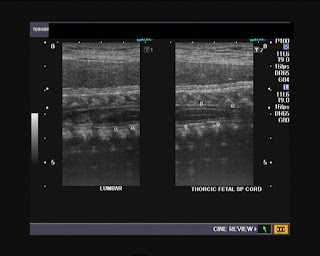Ultrasound video clips of fetal movement in 9 week old fetus (first trimester):
To the layman, or the expectant mother the fetus begins to move when she actually feels the fetus kicking or punching within her womb. This is at about 22 to 26 weeks onwards. But the sonologist can detect fetal movement much earlier. In fact movements of the fetus begin in the early part of pregnancy (as early as 6 weeks) when the fetus actually stretches its back and neck.This ultrasound video clip shows fetal movement in a 9 week old fetus:
Another ultrasound video clip of the same fetus (9weeks)- observe the sharp movements as the fetus kicks and wriggles:
Ultrasound video -Fetus at 13 weeks:
The ultrasound clip below shows the fetal legs (13 week old fetus):
Fetal spine at 13 weeks:
The video clip below shows long section of the fetal spine (13 weeks)- the spinal cord is barely visible within the bony canal. The resemblance to fish bone is striking at this age.
Fetal head at 13 weeks:
This video clip shows a transverse section of the fetal head with the main feature being the large whitish "masses" (lumps) within the fetal cranium- these are the choroid plexuses within the brain. This is a normal appearance and should not be mistaken for a fetal anomaly.
Fetal hand at 13 weeks:
It is difficult to capture the flicking, fleeting movements of the fetal limbs, at this young fetal age. But this ultrasound video shows the fetal hand with a glimpse of the fingers.
Umbilical cord at 13 weeks pregnancy:
The umbilical cord can be seen easily at very early stages of pregnancy. This color Doppler video clip shows the normal umbilical cord with the twisted umbilical arteries and veins seen well. Note the pulsations of the vessels within the cord.
Fetus at 16 weeks: (ultrasound video clips):
Fetal hands (open) with movement:
Even at this early stage of fetal development, the 16 week old fetus shows the well developed fingers, with the phalanges (bones of the digits) and the metacarpals (hand bones) seen as (hyperechoic) white lines.
And now the normal fetal head and brain at 16 weeks:
At 16 weeks, the fetal calvarium (head) is largely filled by the choroid plexus (the large whitish masses- arrowed), with the cerebrum (large brain forming a thin hypoechoic/ dark area around it). The choroid plexus is a vascular tissue that secretes fluid (the cerebro -spinal fluid) that bathes the brain and spinal cord and fills the cavity within the brain (the cerebral ventricles).
And now we see this ultrasound video clip of the fetal spine (16 weeks):
At this early age, the spine has the characteristic fish bone appearance. The early spinal cord occupies the spinal canal (seen as those long thin whitish- (echogenic) lines within the spinal canal.
And lastly, this coronal section (parallel to the face) video clip shows the fetal face with the eyes and mouth. Observe closely- the fetal mouth is seen opening and closing:
Fetal anatomy at 23 weeks:
Both fetal hands with the fingers are seen near the head in this fetal ultrasound video.
Fetal anatomy in 3rd trimester (last 3 months of gestation):
Here is a nice ultrasound video clip of fetus in the process of yawning. Observe how the lips open during the fetal yawn. This was a 3rd trimester (32 week old fetus).
Another ultrasound video of a third trimester (more than 24 weeks) fetus in the process of swallowing amniotic fluid. The fetal tongue, lips and nose are seen in profile (side view) in this sagittal section:
This sonographic video clip shows the fetal upper limb, including the elbow and the clenched fetal hand.
And this video of the fetal lower limb from the thigh to the foot. Observe the fetus attempting to "kick" the walls of the uterus.
From the external anatomy of the fetus to more serious study- the fetal arch of the aorta is seen originating from the left ventricle outflow tract and extending down to traverse the fetal thorax and abdomen as it becomes the fetal descending aorta, in these color Doppler ultrasound video clips (22 week old fetus). Arrows point to the fetal descending aorta:
Here is another color Doppler video of the fetal aorta. I believe one can see the fetal ductus arteriosus emerging from the inferior aspect of the arch of the aorta in these clips. For more images and discussion of normal fetal anatomy, visit: http://www.ultrasound-images.com/fetus-general.htm and
http://www.ultrasound-images.com/fetal-chest.htm
Fetal spinal cord (35 weeks gestational age):
Here are some still images showing the spinal cord of a fetus at 35 weeks gestational age:
I first captured this image showing the thoraco-lumbar region of the spinal cord with a convex 4 Mhz probe.
 Then, I repeated the scan with a 9 Mhz probe. The tapered filum terminale and terminal part (conus medullaris) of the cord are seen in this ultrasound image (below):
Then, I repeated the scan with a 9 Mhz probe. The tapered filum terminale and terminal part (conus medullaris) of the cord are seen in this ultrasound image (below): The spinal cord (arrows) is the hypoechoic tubular structure between those 2 echogenic (bright) membranes (the dura mater) within the spinal canal.
Reference: http://www.ajronline.org/cgi/reprint/164/2/421
http://www.jultrasoundmed.org/cgi/reprint/25/11/1397.pdf
Fetal ear (35 weeks gestational age):
This ultrasound image shows the fetal external ear with the external auditory canal (arrows):These ultrasound video clips show the pinna of the fetal ear with the anechoic external auditory canal (external auditory meatus) reaching deep into the fetal skull.
The same part of the fetal ear seen with arrows pointing to the fetal external auditory canal (meatus) (the part of the external ear). The external auditory canal (meatus) is the part of the ear that extends from the pinna to the middle ear, (the part of the ear that can be seen).



No comments:
Post a Comment